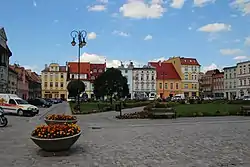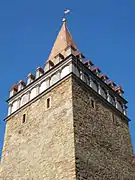Głuchołazy
Głuchołazy [ɡwuxɔˈwazɨ] (Czech: Hlucholazy; German: Bad Ziegenhals; Silesian: Koźo Szyja) is a town in southwestern Poland with approximately 13,534 inhabitants (2019). It is located within the Nysa County of Opole Voivodeship, near the border with the Czech Republic, and is the administrative seat of Gmina Głuchołazy.
Głuchołazy | |
|---|---|
 Market Square in the Old Town | |
 Flag  Coat of arms | |
 Głuchołazy | |
| Coordinates: 50°18′47″N 17°22′27″E | |
| Country | |
| Voivodeship | Opole |
| County | Nysa |
| Gmina | Głuchołazy |
| Town rights | 13th century |
| Government | |
| • Mayor | Edward Szupryczyński |
| Area | |
| • Total | 6.83 km2 (2.64 sq mi) |
| Population (2019-06-30[1]) | |
| • Total | 13,534 |
| • Density | 2,000/km2 (5,100/sq mi) |
| Time zone | UTC+1 (CET) |
| • Summer (DST) | UTC+2 (CEST) |
| Postal code | 48-340 |
| Area code(s) | +48 77 |
| Car plates | ONY |
| Website | http://www.glucholazy.pl |
Geography
The town is located in the historic Upper Silesia region on the northern slopes of the Opawskie Mountains, in the valley of the Biała River. As of 2019, it has 13,534 inhabitants.
Coat of arms
Głuchołazy has a canting arms – the shield features a goat's head in reference to its former name Koziaszyja (in Polish)/Ziegenhals (in German)/Capricolium (in Latin), which literally means "goat's neck". Other archaic Polish name for the town is Cygenhals.
History

The settlement in the episcopal Duchy of Nysa within fragmented Poland was established about 1220 by Bishop Wawrzyniec of Wrocław, who invited German settlers to build up a stronghold against the threatening forces of the Přemyslid margrave Vladislaus III of Moravia, brother of King Ottokar I of Bohemia. It was granted town rights between 1220 and 1249.[2] In the mid-13th century, the church of St. Lawrence was built, the name of which probably refers to the town's founder, bishop Wawrzyniec (Lawrence).[2] The place soon became an important site of iron ore and gold mining, later run by the Thurzó and Fugger families. By the mid-14th century the defensive walls and tower were erected.[2] The town was devastated in 1428 during the Hussite Wars. In 1445 it passed to Duchy of Głogówek under local Polish Duke Bolko V the Hussite and in 1450 it was again reintegrated with the Duchy of Nysa, and remained part of it in the following centuries.[2]
The town was plundered during the Thirty Years' War (1618–1648).[2] After the First Silesian War and the 1742 Treaty of Breslau the Duchy of Nysa was partitioned and Głuchołazy became a Prussian bordertown, while the adjacent area around Zlaté Hory remained with Austrian Silesia. In 1834 the town suffered a fire, and in the following decades large parts of the medieval walls were demolished. In the 19th century it became a spa town.
During World War II, the Germans established the E355, E371, E476 and possibly also E574 working parties of the Stalag VIII-B/344 prisoner-of-war camp in the town.[3] In the final stages of the war, the populace was evacuated in January 1945.[2] Retreating Germans blew up bridges behind them, and finally left the town in May 1945.[2] After the war the remaining German population was expelled and with the implementation of the Oder-Neisse line in 1945, the area was transferred to the Republic of Poland, all in accordance to the Potsdam Agreement. The town was repopulated by Poles, many of whom were displaced from former eastern Poland annexed by the Soviet Union, as well as settlers from war-devastated central Poland, especially from the area of Myszków.[2] The first post-war mayor of Głuchołazy was Szymon Koszyk, pre-war Polish activist, writer and publicist in Upper Silesia and participant in the Silesian Uprisings.
Notable people
- Roland Gumpert (born 1944), engineer and founder of the Gumpert sports car company
- Mieczysław Walkiewicz (born 1949), politician, member of the Polish Sejm
- Andrzej Sośnierz (born 1951), politician and physician
- Michał Bajor (born 1957), actor and musician
- Ewa Chrobak (born 1958), activist, author of the logo of the Order of the Smile
- Roman Dąbrowski (born 1972), footballer
- Jakub Ćwiek (born 1982), fantasy writer
- Kamil Bortniczuk (born 1983), politician, member of the Polish Sejm
- Agnieszka Śnieżek (born 1991), female basketball player
Twin towns – sister cities
Gallery
.jpg.webp) Saint Lawrence church seen from the Market Square
Saint Lawrence church seen from the Market Square Spa Park in autumn
Spa Park in autumn Skowronek rehabilitation and recreation center
Skowronek rehabilitation and recreation center Upper Gate Tower, a remnant of the medieval defensive walls
Upper Gate Tower, a remnant of the medieval defensive walls Saint Francis church
Saint Francis church A monument dedicated to veterans of the struggle for Polish independence
A monument dedicated to veterans of the struggle for Polish independence Memorial stone to Jerzy Popiełuszko
Memorial stone to Jerzy Popiełuszko
References
- "Population. Size and structure and vital statistics in Poland by territorial divison in 2019. As of 30th June". stat.gov.pl. Statistics Poland. 2019-10-15. Retrieved 2020-02-14.
- "Początki Naszego Miasta". Glucholazy.pl (in Polish). Retrieved 14 March 2020.
- "Working Parties". Stalag VIIIB 344 Lamsdorf. Retrieved 14 March 2020.
External links
| Wikimedia Commons has media related to Głuchołazy. |
- Official town webpage (in Polish)
- Głuchołazy Unofficial Website (in Polish)
- Głuchołazy Panorama (in Polish)
- Głuchołazy in Photography (in Polish)
- Jewish Community in Głuchołazy on Virtual Shtetl